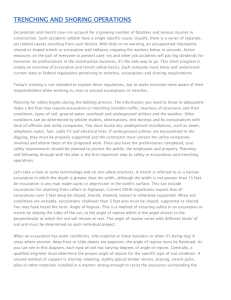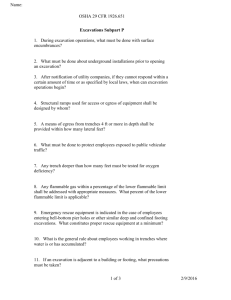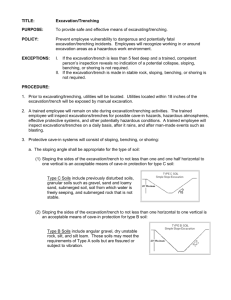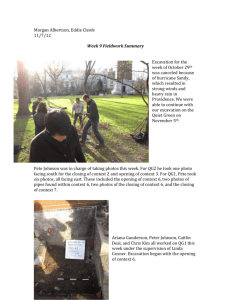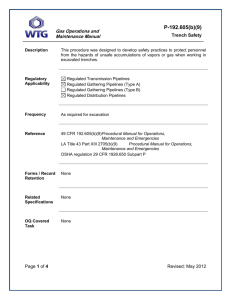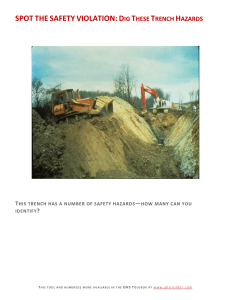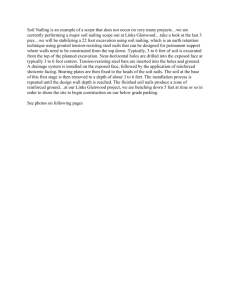Oklahoma State University
advertisement
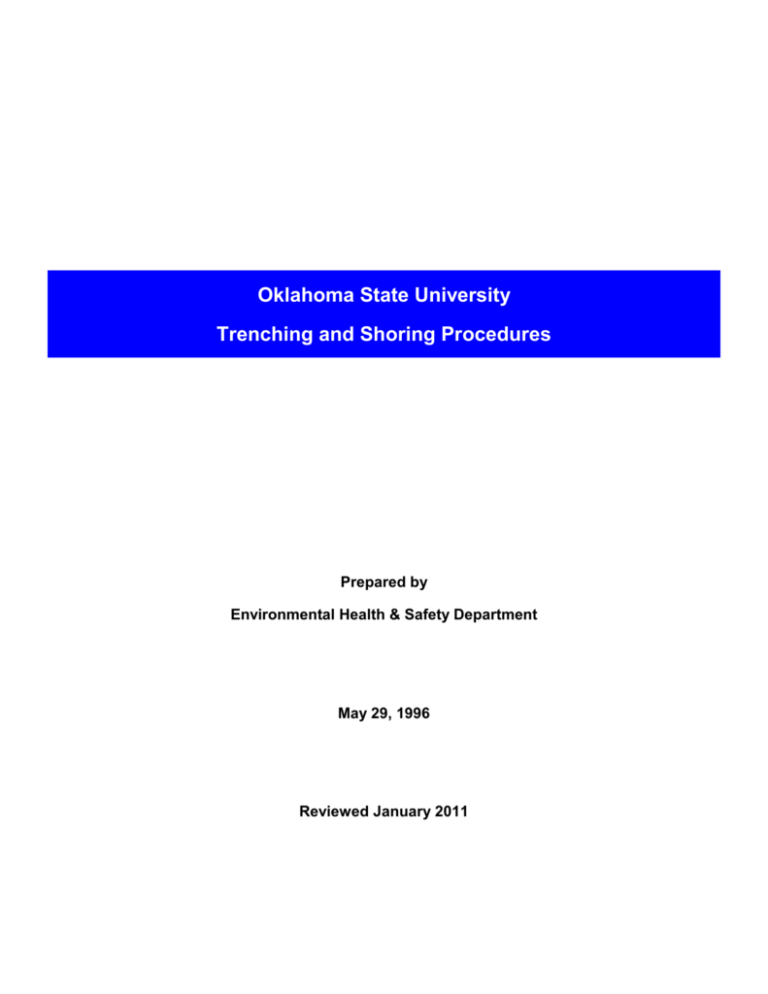
Oklahoma State University Trenching and Shoring Procedures Prepared by Environmental Health & Safety Department May 29, 1996 Reviewed January 2011 OSU Trenching/Shoring Manual – Page 2 Scope and Application: This policy sets forth the official practices required for excavations made by Oklahoma State University employees on property owned by Oklahoma State University. Definitions: Aluminum hydraulic shoring means an engineered shoring system comprised of aluminum hydraulic cylinders (crossbraces),used in conjunction with vertical rails (uprights) or horizontal rails (walers). Such system is designed specifically to support the sidewalls of an excavation and prevent cave-ins. Benching means a method of protecting employees from cave-ins by excavating the sides of an excavation to form one or a series of horizontal levels or steps, usually with vertical or near-vertical surfaces between levels. Cave-in means the separation of a mass of soil or rock material from the side of an excavation, or the loss of soil from under a trench shield or support system, and its sudden movement into the excavation, either by falling or sliding, in sufficient quantity so that it could entrap, bury, or otherwise injure and immobilize a person. Competent person means one who is capable of identifying existing and predictable hazards in the surroundings, or working conditions which are unsanitary, hazardous, or dangerous to employees, and who has authorization to take prompt corrective measures to eliminate them. All competent persons must complete the four hour Physical Plant trenching and shoring class, successfully pass the exam, and be certified for successful completion of the class. A competent person should have and be able to demonstrate the following: 1. Training, experience, and knowledge of: 2. Ability to detect: 3. soil analysis, use of protective systems, and requirements of 29 CFR 1926 Subpart P. conditions that could result in cave-ins, failures in protective systems, hazardous atmospheres, andother hazards including those associated with confined spaces. Authority to take prompt corrective measures to eliminate existing and predictable hazards and to stop work when required. Excavation means any man-made cut, cavity, trench, or depression in an earth surface, formed by earth removal. Registered professional engineer means a person who is registered as a professional engineer. January 2011 OSU Trenching/Shoring Manual – Page 3 Shield (shield system) means a structure that is able to withstand the forces imposed on it by a cave-in and thereby protect employees with the structure. Shields can be permanent structure or can be designed to be portable and moved along as work progresses. Also known as trench box or trench shield. Shoring (shoring system) means a structure such as a metal hydraulic, mechanical or timber shoring system that supports the sides of an excavation and which is designed to prevent caveins. Sloping (sloping system) means a method of protecting employees from cave-ins by excavating to form sides of an excavation that are inclined away from the excavation so as to prevent cave-ins. The angle of incline varies with differences in such factors as the soil type, environmental conditions of exposure, and application of surcharge loads. Trench (trench excavation) means a narrow excavation (in relation to its length) made below the surface of the ground. In general, the depth is greater than the width, but the width of a trench is not greater than 15 feet. If forms or other structures are installed or constructed in an excavations as to reduce the dimension measure from the forms or structure to the side of the excavation to 15 feet or less, the excavation is also considered to be a trench. General Requirements: All excavations shall be made in accordance with the rules, regulations, requirements, and guidelines set forth in 29 CFR 1926.650, .651, and .652; the Occupational Safety and Health Administration's standard on Excavations, except where otherwise noted below. Procedures A competent person shall be placed in charge of all excavations. Underground utilities must be located and marked before excavation begins. Employees are not are allowed in the excavation while heavy equipment is digging. Inspections The competent person shall conduct inspections: Daily and before the start of each shift. As dictated by the work being done in the trench. After every rain storm. After other events that could increase hazards, such as snowstorm, windstorm, thaw, earthquake, dramatic change in weather, etc. When fissures, tension cracks, sloughing, undercutting, water seepage, bulging at the bottom, or other similar conditions occur. When there is a change in the size, location, or placement of the spoil pile. When there is any indication of change or movement in adjacent structures. For excavations 4 feet or greater in depth, a trench inspection form shall be filled out for each inspection. January 2011 OSU Trenching/Shoring Manual – Page 4 Soil Types Type A - Most stable: clay, silty clay, and hardpan (resists penetration). No soil is Type A if it is fissured, is subject to vibration or any type, has previously been disturbed, or has seeping water. Type B - Medium stability: silt, sandy loam, medium clay and unstable dry rock; previously disturbed soils unless otherwise classified as Type C; soils that meet the requirements of Type A soil but are fissured or subject to vibration. Type C - Least stable: gravel, loamy sand, soft clay, submerged soil or dense, heavy unstable rock, and soil from which water is freely seeping. Layered geological strata - Where soils are configured in layers, the soil must be classified on the basis of the soil classification of the weakest soil layer. Each layer may be classified individually if a more stable layer lies below a less stable layer, i.e., where a Type C soil rests on top of stable rock. (see illustrations in Appendix) Because most excavations on OSU property will be conducted in order to repair / replace existing pipelines or equipment (i.e, the soil has been previously disturbed), excavations shall be made to meet the requirements for Type B or Type C soils only, as appropriate. Testing Methods The competent person in charge of the excavation shall be responsible for determining whether the soil is Type B or C. The competent person shall use a visual test coupled with one or more manual tests. Visual test In addition to checking the items on the trench inspection form, the competent person should perform a visual test to evaluate the conditions around the site. In a visual test, the entire excavation site is observed, including the soil adjacent to the site and the soil being excavated. The competent person also checks for any signs of vibration. During the visual test, the competent person should check for crack-line openings along the failure zone that would indicate tension cracks, look for existing utilities that indicate that the soil has been previously disturbed, and observe the open side of the excavation for indications of layered geologic structuring. This person should also look for signs of bulging, boiling, or sloughing, as well as for signs of surface water seeping from the sides of the excavation or from the water table. In addition, the area adjacent to the excavation should be checked for signs of foundations or other intrusions into the failure zone, and the evaluator should check for surcharging and the spoil distance from the edge of the excavation. January 2011 OSU Trenching/Shoring Manual – Page 5 Manual tests Thumb penetration test Attempt to press the thumb firmly into the soil in question. If the thumb penetrates no further than the length of the nail, it is probably Type B soil. If the thumb penetrates the full length of the thumb, it is Type C. It should be noted that the thumb penetration test is the least accurate testing method. Dry strength test Take a sample of dry soil. If it crumbles freely or with moderate pressure into individual grains it is considered granular (Type C). Dry soil that falls into clumps that subsequently break into smaller clumps (and the smaller clumps can only be broken with difficulty) it is probably clay in combination with gravel, sand, or silt (Type B). Plasticity or Wet Thread Test Take a moist sample of the soil. Mold it into a ball and then attempt to roll it into a thin thread approximately 1/8 inch in diameter by two inches in length. If the soil sample does not break when held by one end, it may be considered Type B. A pocket penetrometer, shearvane, or torvane may also be used to determine the unconfined compression strength of soils. Spoil Temporary spoil must be placed no closer than 2 feet from the surface edge of the excavation, measured from the nearest base of the spoil to the cut. This distance should not be measured from the crown of the spoil deposit. This distance requirement ensures that loose rock or soil from the temporary spoil will not fall on employees in the trench. Spoil should be placed so that it channels rainwater and other run-off water away from the excavation. Spoil should be placed so that it cannot accidentally run, slide, or fall back into the excavation. Permanent spoil should be placed some distance from the excavation. Surface Crossing of Trenches Surface crossing of trenches should not be made unless absolutely necessary. However, if necessary, they are only permitted under the following conditions: Vehicle crossings must be designed by and installed under the supervision of a registered professional engineer. Walkways or bridges must: - have a minimum clear width of 20 inches, - be fitted with standard rails, and - extend a minimum of 24 inches past the surface edge of the trench. January 2011 OSU Trenching/Shoring Manual – Page 6 Ingress and Egress Trenches 4 feet or more in depth shall be provided with a fixed means of egress. Spacing between ladders or other means of egress must be such that a worker will not have to travel more than 25 feet laterally to the nearest means of egress. Ladders must be secured and extend a minimum of 36 inches above the landing. Metal ladders should be used with caution, particularly when electric utilities are present. Exposure to Vehicles Employees exposed to vehicular traffic shall be provided with and required to wear reflective vests or other suitable garments marked with or made of reflectorized or high-visibility materials. Trained flag persons, signs, signals, and barricades shall be used when necessary. Exposure to Falling Loads All employees on an excavation site must wear hard hats. Employees are not allowed to work under raised loads. Employees are not allowed to work under loads being lifted or moved by heavy equipment used for digging or lifting. Employees are required to stand away from equipment that is being loaded or unloaded to avoid being struck by falling materials or spillage. Equipment operators or truck drivers may remain in their equipment during loading and unloading if the equipment is properly equipped with a cab shield or adequate canopy. Warning Systems for Mobile Equipment The following steps should be taken to prevent vehicles from accidentally falling into the trench: Barricades must be installed where necessary, Hand or mechanical signals must be used as required, Stop logs must be installed if there is danger of vehicles falling into the trench. Soil should be graded away from the excavation; this will assist in vehicle control and channeling of run-off water. January 2011 OSU Trenching/Shoring Manual – Page 7 Hazardous Atmospheres and Confined Spaces Employees shall not be permitted to work in hazardous and/or toxic atmospheres. Such atmospheres include those with: less than 19.5% oxygen, a combustible gas concentration greater than 20% of the lower flammable limit, and, concentrations of hazardous substance that exceed those specified in the Threshold Limit Values for airborne contaminants established by the ACGIH. All operations involving such atmospheres must be conducted in accordance with OSHA requirements for occupational health and environmental controls for personal protective equipment and for lifesaving equipment. Engineering controls (such as ventilation) and respiratory equipment may be required. Testing for Atmospheric Contaminants If there is any possibility that the trench or excavation could contain a hazardous atmosphere, atmospheric testing must be conducted prior to entry. Conditions that might warrant atmospheric testing would be if the excavation was made in a landfill area or if the excavation was crossed by, was adjacent to, or contained pipelines containing a hazardous material (for example, natural gas lines). Testing should be conducted before employees enter the trench and should be done regularly to ensure that the trench remains safe. The frequency of testing should be increased if equipment is operating in the trench. Testing frequency should also be increased if welding, cutting, or burning is done in the trench. Employees required to wear respiratory protection must be trained, fit-tested, and enrolled in a respiratory protection program. Some trenches qualify as confined spaces. When this occurs, compliance with OSU's Confined Space Program is also required. Standing Water and Water Accumulation Methods for controlling standing water and water accumulation must be provided and should consist of the following if employees must work in the excavation: Use of special support or shield systems approved by a registered professional engineer. Water removal equipment such as well pointing, used and monitored by a competent person. Safety harnesses and lifelines used in conformance with 29 CFR 1926.104. Employees removed from the trench during rainstorms. Trenches carefully inspected by a competent person after each rain and before employees are permitted to re-enter the trench. January 2011 OSU Trenching/Shoring Manual – Page 8 Benching, Sloping, Shoring, and Shielding Requirements All excavations or trenches of 4' or greater in depth shall be appropriately benched, shored, or sloped according to the procedures and requirements set forth in OSHA's Excavation standard, 29 CFR 1926.650, .651, and .652. Excavations or trenches 20 feet deep or greater must have a protective system designed by a registered professional engineer. Excavations under the base of footing of a foundation or wall requires a support system designed by a registered professional engineer. Sidewalks and pavement shall not be undermined unless a support system or another method of protection is provided to protect employees from their possible collapse. Sloping Maximum allowable slopes for excavations less than 20' based on soil type and angle to the horizontal are as follows: Soil Type Height/depth ratio Slope angle Type B 1:1 45 degrees Type C 1 1/2:1 34 degrees A 10-foot-deep trench in Type B soil would have to be sloped to a 45 degree angle, or sloped 10 feet back in both directions. Total distance across a 10-foot-deep trench would be 20 feet. In Type C soil, the trench would be sloped at a 34 degree angle, or 15 feet back in both directions for a total of 30 feet across. Benching There are two basic types of benching, simple and multiple. The type of soil determines the horizontal to vertical ratio of the benched side. In Type B soil, the vertical height of the benches must not exceed 4 feet. Benches must be below the maximum allowable slope for that soil type. In other words, a 10-foot deep trench in Type B soil must be benched back 10 feet in each direction, with the maximum of a 45-degree angle. Benching is not allowed in Type C soil. Shoring Shoring or shielding is used when the location or depth of the cut makes sloping back to the maximum allowable slope impractical. There are two basic types of shoring, timber and aluminum hydraulic. Because the Physical Plant has aluminum hydraulic shores, this section will focus on them. Hydraulic shoring provides a critical safety advantage over timber shoring because workers do not have to enter the trench to install them. They are also light enough to be installed by one worker; they are gauge-regulated to ensure even distribution of pressure along the trench line; and they January 2011 OSU Trenching/Shoring Manual – Page 9 can be adapted easily to various trench depths and widths. However, if timber shoring is used, it must meet the requirements of 29 CFR 1926.650, .651, and .652. All shoring shall be installed from the top down and removed from the bottom up. Hydraulic shoring shall be checked at least once per shift for leaking hoses and/or cylinders, broken connections, cracked nipples, bent bases, and any other damaged or defective parts. The top cylinder of hydraulic shoring shall be no more than 18 inches below the top of the excavation. The bottom of the cylinder shall be no higher than four feet from the bottom of the excavation. (Two feet of trench wall may be exposed beneath the bottom of the rail or plywood sheeting, if used.) Three vertical shores, evenly spaced, must be used to form a system. Wales are installed no more than two feet from the top, no more than four feet from the bottom, and no more than four feet apart, vertically. Hydraulic shores must be installed in accordance with Table D - 1.2 and Table D - 1.3 (attached) in soil Type B. Hydraulic shores must be installed with sheeting in accordance with Table D - 1.4 (attached) in soil Type C. Shielding Trench boxes are different from shoring because, instead of shoring up or otherwise supporting the trench face, they are intended primarily to protect workers form cave-ins and similar incidents. The excavated area between the outside of the trench box and the face of the trench should be as small as possible. The space between the trench box and the excavation side must be backfilled to prevent lateral movement of the box. Shields may not be subjected to loads exceeding those which the system was designed to withstand. Trench boxes are generally used in open areas, but they also may be used in combination with sloping and benching. The box must extend at least 18 inches above the surrounding area if there is sloping toward the excavation. This can be accomplished by providing a benched area adjacent to the box. Any modifications to the shields must be approved by the manufacturer. Shields may ride two feet above the bottom of an excavation, provided they are calculated to support the full depth of the excavation and there is no caving under or behind the shield. Workers must enter and leave the shield in a protected manner, such as by a ladder or ramp. Workers may not remain in the shield while it is being moved. January 2011 OSU Trenching/Shoring Manual – Page 10 Appendix ............................................................................................................................................. page Layered Geological Strata Soil B layered over Soil C ............................................................................................. 11 Soil C layered over Soil B ............................................................................................. 11 Basic Types of Benching Single ............................................................................................................................. 12 Multiple........................................................................................................................... 12 Illustrations of Simple Slopes Simple Slope in Type B Soil ......................................................................................... 13 Simple Slope in Type C Soil ......................................................................................... 13 Table D-1.2 Aluminum Hydraulic Shoring – Vertical Shores for Soil Type B ............................... 14 Table D-1.3 Aluminum Hydraulic Shoring – Waler Systems for Soil Type B ............................... 15 Table D-1.4 Aluminum Hydraulic Shoring – Waler Systems for Soil Type C ............................... 16 Illustrations of Aluminum Hydraulic Shoring Systems Vertical (spot bracing) .................................................................................................. 17 Vertical (with plywood) ................................................................................................. 17 Vertical (stacked) .......................................................................................................... 17 Waler System (typical) .................................................................................................. 17 January 2011 OSU Trenching/Shoring Manual – Page 11 Layered Geological Strata Soil B layered over Soil C Soil C layered over Soil B January 2011 OSU Trenching/Shoring Manual – Page 12 Basic Types of Benching All benched excavations 20 feet or less in depth shall have a maximum allowable slope of 1:1. Single Bench Multiple Bench January 2011 OSU Trenching/Shoring Manual – Page 13 Illustration of Simple Slope Trenching in B and C Type Soils Type B Soil Type C Soil All simple slope excavations 20 feet or less in depth shall have a maximum allowable slope of 1½ : 1 January 2011 OSU Trenching/Shoring Manual – Page 14 Table D-1.2 Aluminum Hydraulic Shoring – Vertical Shores for Soil Type B HYDRAULIC CYLINDERS DEPTH OF TRENCH -(FEET) MAXIMUM HORIZONTAL SPACING -(FEET) OVER 5 UP TO 10 8 OVER 10 UP TO 15 6.5 OVER 15 UP TO 20 5.5 OVER 20 MAXIMUM VERTICAL SPACING -(FEET) 4 WIDTH OF TRENCH (FEET) UP TO 8 OVER 8 UP TO 12 OVER 12 UP TO 15 2-INCH DIAMETER **2-INCH DIAMETER 3-INCH DIAMETER For applications other than those listed in the tables, refer to CFR 1926.652(c)(2) for use of manufacturer’s tabulated data. For trench depths in excess of 20 feet, refer to CFR 1926.652(c)(2) and CFR 1926(c)(3). **2-inch diameter cylinders, at this width, shall have structural steel tube (3.5 x 3.5 x 0.1875) oversleeves, or structural oversleeves of manufacturer’s specification, extending the full, collapsed length. January 2011 OSU Trenching/Shoring Manual – Page 15 Table D-1.3 Aluminum Hydraulic Shoring – Waler Systems for Soil Type B HYDRAULIC CYLINDERS TIMBER UPRIGHTS WIDTH OF TRENCH (FEET) MAX. HORIZ. SPACING (ON CENTER) WALES DEPTH OF TRENCH (FEET) VERT. SPACING (FEET) OVER 5 UP TO 10 4 OVER 10 UP TO 15 4 OVER 15 UP TO 20 OVER 20 4 *SECTION MODULUS (IN3) UP TO 8 OVER 8 UP TO 12 OVER 12 UP TO 15 HORIZ. SPACING CYLINDER DIAMETER HORIZ. SPACING CYLINDER DIAMETER HORIZ. SPACING CYLINDER SPACING 3.5 8.0 2 IN. 8.0 2 IN. 8.0 3 IN. 7.0 9.0 2 IN. 9.0 2 IN. 9.0 3 IN. 14.0 12.0 3 IN. 12.0 3 IN. 12.0 3 IN. 3.5 6.0 2 IN. 6.0 2 IN. 6.0 3 IN. 7.0 8.0 3 IN. 8.0 3 IN. 8.0 3 IN. 14.0 10.0 3 IN. 10.0 3 IN. 10.0 3 IN. 3.5 5.5 2 IN. 5.5 2 IN. 5.5 3 IN. 7.0 6.0 3 IN. 6.0 3 IN. 6.0 3 IN. 14.0 9.0 3 IN. 9.0 3 IN. 9.0 3 IN. SOLID SHEET 2 FT. 3 FT. --- --- 3x12 --- 3x12 --- 3x12 --- --- For applications other than those listed in the tables, refer to CFR 1926.652(c)(2) for use of manufacturer’s tabulated data. For trench depths in excess of 20 feet, refer to CFR 1926.652(c)(2) and CFR 1926.652(c)(3). * Consult product manufacturer and/or qualified engineer for Section Modulus of available wales. January 2011 OSU Trenching/Shoring Manual – Page 16 Table D-1.4 Aluminum Hydraulic Shoring – Waler Systems for Soil Type C HYDRAULIC CYLINDERS TIMBER UPRIGHTS WIDTH OF TRENCH (FEET) MAX. HORIZ. SPACING (ON CENTER) WALES DEPTH OF TRENCH (FEET) VERT. SPACING (FEET) OVER 5 UP TO 10 4 OVER 10 UP TO 15 4 OVER 15 UP TO 20 OVER 20 4 *SECTION MODULUS (IN3) UP TO 8 OVER 8 UP TO 12 OVER 12 UP TO 15 HORIZ. SPACING CYLINDER DIAMETER HORIZ. SPACING CYLINDER DIAMETER HORIZ. SPACINT CYLINDER DIAMETER 3.5 6.0 2 IN. 6.0 **2 IN. 6.0 3 IN. 7.0 6.5 2 IN. 6.5 **2 IN. 6.5 3 IN. 14.0 10.0 3 IN. 10.0 3 IN. 10.0 3 IN. 3.5 4.0 2 IN. 4.0 **2 IN. 4.0 3 IN. 7.0 5.5 3 IN. 5.5 3 IN. 5.5 3 IN. 14.0 8.0 3 IN. 8.0 3 IN. 8.0 3 IN. 3.5 3.5 2 IN. 3.5 **2 IN. 3.5 3 IN. 7.0 5.0 3 IN. 5.0 3 IN. 5.0 3 IN. 14.0 6.0 3 IN. 6.0 3 IN. 6.0 3 IN. SOLID SHEET 2 FT. 3 FT. 3x12 --- --- 3x12 --- --- 3x12 --- --- For applications other than those listed in the tables, refer to CFR 1926.652(c)(2) for use of manufqcturer’s tabulated data. For trench depths in excess of 20 feet, refer to CFR 1926.652(c)(2) and CFR 1926.652(c)(3). * Consult product manufacturer and/or qualified engineer for Section Modulus of available wales. ** 2-inch diameter cylinders, at this width, shall have structural steel tube (3.5 x 3.5 x 0.1875) oversleeves, or structural oversleeves of manufacturer’s specification, extending the full, collapsed length. January 2011 OSU Trenching/Shoring Manual – Page 17 Aluminum Hydraulic Shoring Systems Vertical (spot bracing) Vertical (stacked) January 2011 Vertical (with plywood) Waler System (typical)
